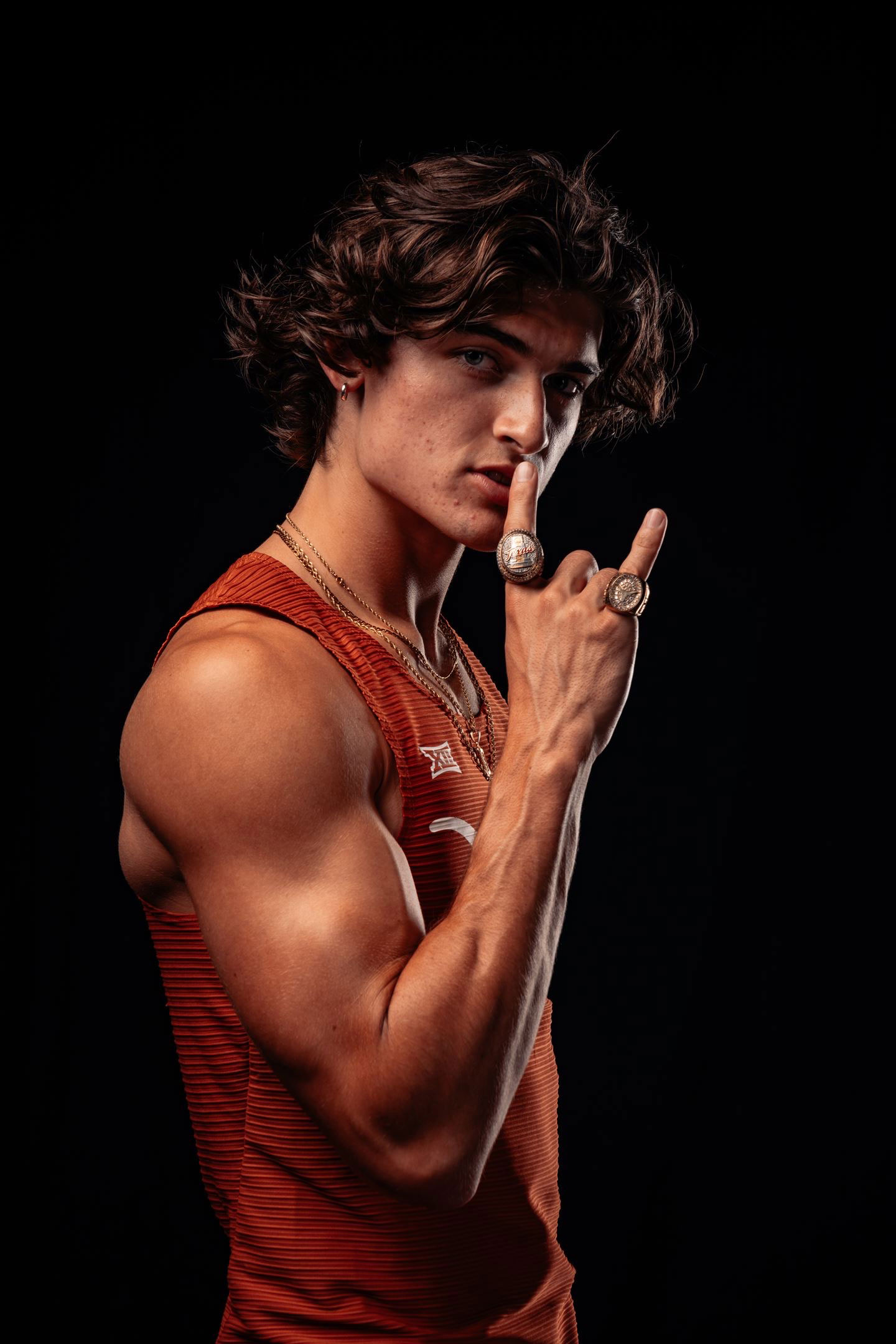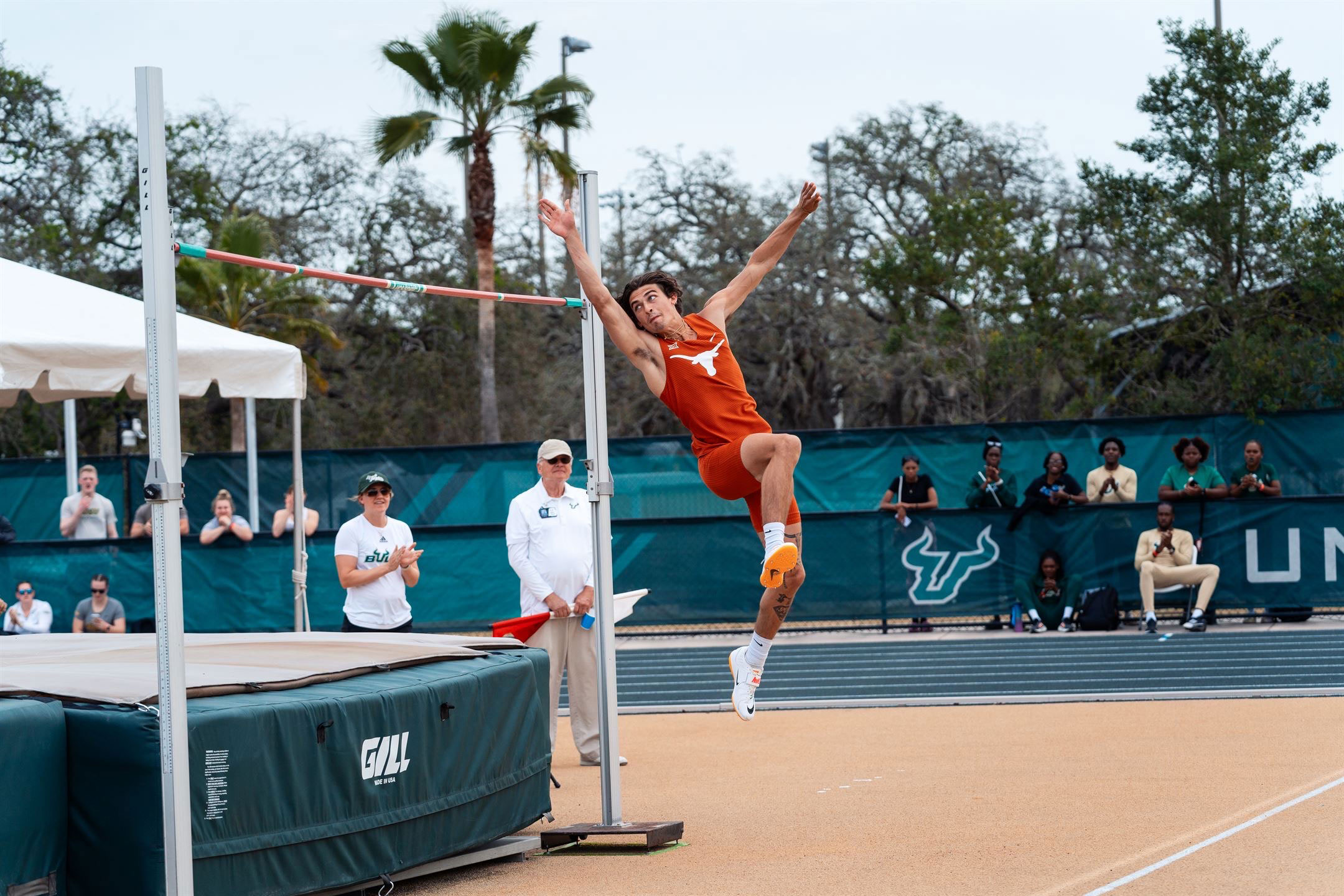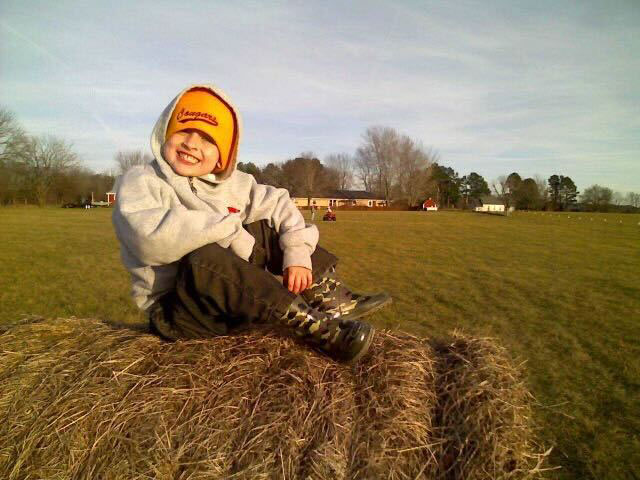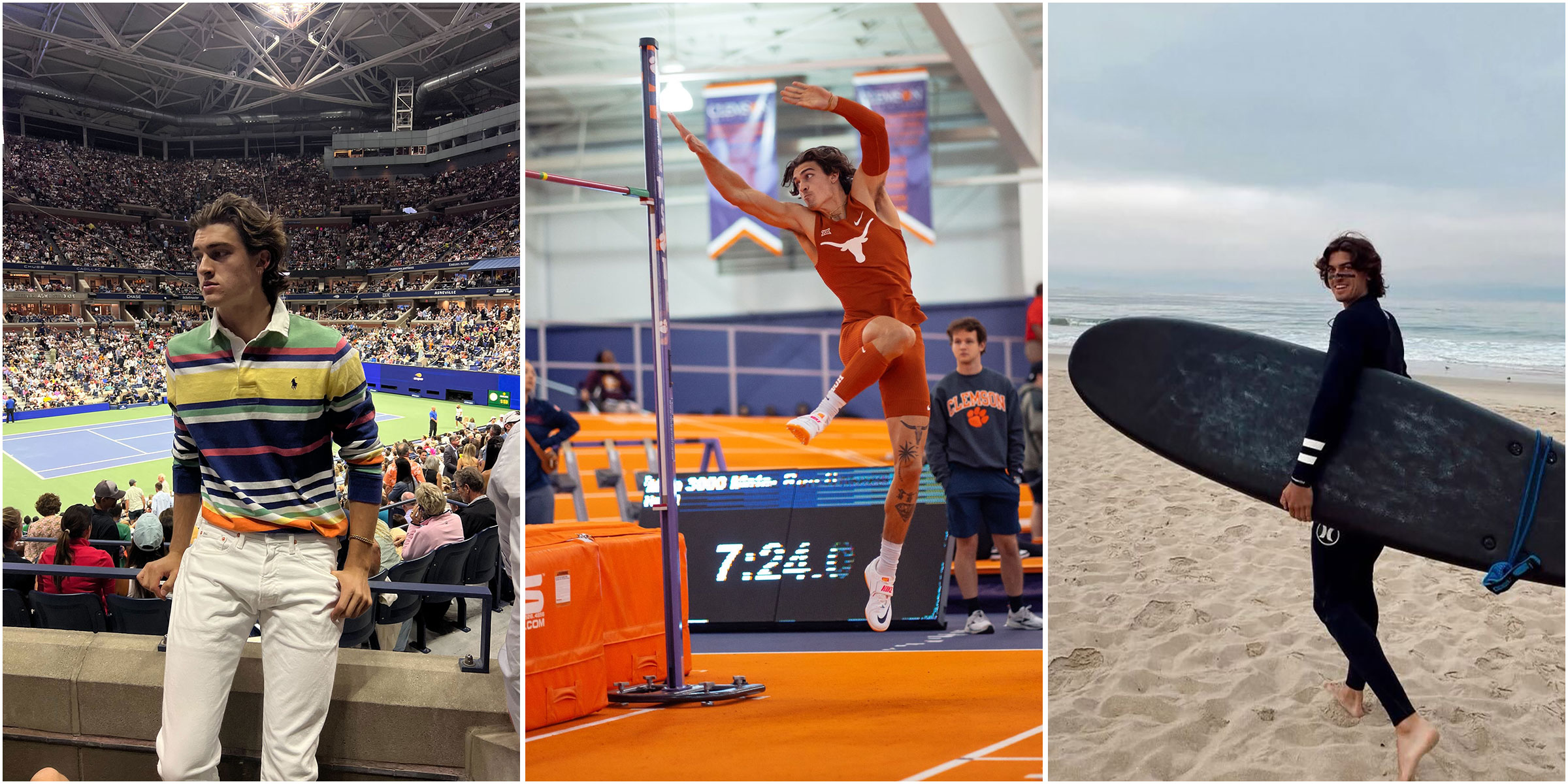
One of the highest-earning college athletes on the planet says a little prayer. Sam Hurley, a University of Texas sophomore, does so before every leap. He prays that God gives him the wings—represented by an angel tattoo on his left calf—to carry him over the high-jump bar. On this bright, 80-degree late-April afternoon in Austin, Hurley sprints toward the bar, his wavy dark-brown hair bouncing in front of a sea of empty stadium seats. The overwhelming majority of college athletes who earn in the neighborhood of $1 million or more to market their name, image, and likeness (NIL), like Hurley does, perform athletic feats before 50,000 to 100,000 fans in packed football stadiums or sold-out basketball arenas. But a few hundred eyes, at most, are fixed on Hurley as he attempts to win the Texas Invitational.
Hurley, 19, soars, arches his back over the 7 ft., ½ in. bar, and flops on the mat. To a smattering of applause at Mike A. Myers Stadium, he hops up, pounds his hand against his chest, and points one finger up in the air. He’s clinched his second meet title of the outdoor track-and-field season. “It was a good day,” Hurley says afterward, “to be great.”
July 1 marks the second anniversary of the day that college athletes, at long last, were given the freedom to profit off their personal brands. After years of sustaining hits in the courts and in the media for allowing schools and administrators and coaches to enrich themselves on the backs of football and basketball players, the NCAA finally relented, and dropped its arcane rules preventing athletes from signing third-party sponsorship deals. Since then, companies and collectives—the nebulous alumni and booster groups pooling money together to entice athletes to their campuses—have been offering athletes deals ranging from millions for multiyear marketing agreements to meal money for an appearance or social media post. Name-brand businesses like Wells Fargo, Sony, and Dunkin’ are competing in this space, as are local car dealerships and taco joints. According to Opendorse, a company that connects athletes with businesses, some 90,000 college athletes have made money on its platform. It expects athletes to have earned more than $100 million in NIL by the end of 2023.
More from TIME
Hurley, the Texas high jumper, presents a crucial case study. Of the 25 college and high school athletes with NIL valuations of $1 million or more, according to On3.com, all except two—Hurley and LSU gymnast Olivia Dunne—play football or basketball, the two sports that drive athletic-department revenues. Like Dunne, Hurley has leveraged his enormous social media following into earnings that, he says, are approaching $1 million. Among the 25 most highly valued athletes, only Bronny James, LeBron’s son, and Dunne have more impressive social media metrics than Hurley (12.9 million followers for James, 11.4 million for Dunne, 5 million for Hurley).
If NIL rules hadn’t changed two years ago, Hurley, who became a TikTok influencer while in high school, would have skipped college. He wouldn’t have been able to earn money while jumping for the Longhorns, or any other school. Since becoming a college athlete, he’s signed NIL deals with brands such as Amazon, Jimmy Dean, Vuori athletic apparel, and Bubble, the skin-care company. Hurley has continued to expand his fan base via TikTok lip-syncs, often sung without a shirt. While Dunne competes in gymnastics, a star Olympic sport with a loyal following on the college level, Hurley participates in a track-and-field discipline that barely causes an Olympic ripple. High jump only made news in the most recent Games in Tokyo because two competitors agreed to share a gold medal. Outside of friends and family—Hurley’s mom, grandmother, and two buddies of his older brother Hootie were in the stands at the Texas Invitational— hard-core college high-jump enthusiasts total a rounding error.
Hurley’s creating a novel path toward college-sports riches. Influencer first and foremost, athlete second, with each job gilding the other. His story, however, also points to the shortcomings of a model that allows athletes to make money only through outside deals and may make people take a careful look at who is benefiting from NIL, who is not, and what still needs to change.
Hurley’s a fine high jumper; he’s qualified for the NCAA National Track and Field Championships, to be held on his home turf in Austin, from June 7 to 10. But the nearly $1 million he’s earned as a college athlete through NIL isn’t commiserate with his value to the University of Texas athletic department. At Texas two sports, football ($161.5 million) and men’s basketball ($23.6 million) accounted for 91% of the athletic department’s haul attributable to a specific sport during the 2021-22 academic year, according to federal data. The school’s 13 other varsity sports teams—track and field among them—accounted for just $18.5 million in revenue, the remaining 9%, combined.

The market has spoken. Outside sponsors value the following Hurley has amassed through his charisma, chiseled abs, and athletic prowess. (He says his ratio of female to male social media followers has changed from 95/5 to 70/30 since he became a college athlete.) He deserves everything he’s earned through NIL. But many of the athletes toiling in the athletic trenches, fueling the $19 billion college-sports industry—who very often are athletes of color—aren’t savvy social media stars. In a professional setting—and no one can reasonably argue that the money at stake in college sports hasn’t turned the games into a professional enterprise—what these athletes lack in sponsorship earnings, they make up for in fair compensation for their work. While Patrick Mahomes earns his millions in endorsements, the less visible players on the Kansas City Chiefs— the offensive and defensive lineman, for example, banging heads on every play—still earn a pretty penny from the team.
Most big-time college football players are receiving some NIL cash—on average $10,000 to $50,000 at Power Five schools from collectives, according to Sports Illustrated. It’s nothing to sneeze at for a college student. Still, these players could be earning much more, if only the schools themselves, who are showering in lucre provided by media-rights contracts, gate receipts, and other sources, were allowed to share revenue with them. If they were allowed to pay them.
In a June 2021 concurring opinion lambasting the NCAA’s amateurism model, Supreme Court Justice Brett Kavanaugh wrote: “Nowhere else in America can businesses get away with agreeing not to pay their workers a fair market rate on the theory that their product is defined by not paying their workers a fair market rate. … The NCAA is not above the law.” He seemed to be inviting further challenges to the underpinnings of college sports: a few such cases are circulating in lower courts, and the California state assembly just passed legislation requiring schools to share new athletic revenues with the athletes themselves.
“We celebrate everyone’s opportunity to earn NIL money,” says Ramogi Huma, president of the National College Players Association, an athletes’ rights organization, who was instrumental in pushing for the California bill. “But not sharing revenue with people generating it is not equity.”
A fairer market for college athletes seems like an inevitable next step in the evolution of the industry. And to Hurley’s credit, he acknowledges the shortcomings in the current system. “There’s enough money in this NCAA world for everyone,” says Hurley. “I’m all for everybody eating.”
Hurley started posting YouTube videos of himself jumping on a trampoline and skateboarding when he was 8. “I always wanted to be an influencer on social media,” says Hurley. He grew up in northwest Arkansas, where his father Edward worked as a real estate developer and his mom Kristy took care of him and his brothers Turner, 26, and Hootie, 24. Hurley was prenaturally athletic. With springs for legs, he could dunk a basketball at age 14, when he was just 5 ft., 6 in. (he’s now 6 ft., 2 in). He was also comfortable hamming it up. “If we’re at the pool, he’s going to do 72 different flips and tricks, and we’ve got to rate them and watch his show,” says Hootie.

His parents divorced when Hurley was in eighth grade, and with his brothers away at college, Hurley found himself alone, splitting his time between his mother and father. “It was the hardest part of my life,” he says. “It was such a drastic change, going from a team of five to kind of feeling solo.”
During his freshman year of high school, however, Hurley discovered TikTok. His first posts, in November 2018, were mostly clips of a scrawny teen backflipping into water. Whereas his early YouTube videos were mostly viewed by his family and a few friends, these TikTok posts quickly racked up tens of thousands of views. “I was like, alright, this could be something,” says Hurley. “Let’s keep it going.” He posted silly videos incessantly—there Hurley goes, jumping into a pile of leaves; there he is waking up on New Year’s Eve, Dolly Parton’s “9 to 5” playing over the clip. A speaker company paid him $45 to plug their product in his Instagram story. Brands started offering him more and more money to partner with him. “I was like, holy crap, this is crazy,” says Hurley. “I realized I can make a career doing this.” He wasn’t wrong: The influencer market is expected to grow to $21.1 billion this year, according to Influencer Marketing Hub.
In less than six months, Hurley acquired a million TikTok followers. On a March 2019 trip to New York City, when he was 15, he posted a message that he’d be hanging out in Times Square in a few hours. “COME MEET ME,” Hurley wrote. He expected 10 or 20 people to show up. Instead, hundreds of teenage girls surrounded him, screaming, “Oh my God!” One held up a pink cell phone and yelled, “Look this way!”
“The police ended up coming up to me and they were like, ‘Ma’am, we need to get you out of here,’” says Kristy. “‘I know he didn’t mean to, but he has started a riot.’” Kristy, the cheerleading captain for the University of Arkansas’ 1994 men’s basketball title run, managed her son’s affairs before he signed with WME to handle his NIL contracts; she now also advises other social media influencers.
That summer, Hurley joined fellow influencer Josh Richards—who now has 26 million TikTok followers—and others on a nationwide tour, meeting fans and posting videos together. The clips have racked up millions of views. Hurley began modeling for Polo Ralph Lauren. “Everybody loves the boy-band effect,” says Hootie, who’s developed a substantial social media following of his own (1.3 million, for example, on TikTok). “It’s nitrous oxide in the algorithm.”
While he was winning devotees on social media and pouring cash into his bank account, some of Hurley’s schoolmates back in Arkansas grew envious. He was already a star track athlete as a freshman. Now he was also stealing attention from the girls on social media? “The upperclassmen hated on me so hard,” Hurley tells me as we eat breakfast at Kerbey Lane Cafe on “The Drag,” the section of Guadalupe Street on the western border of the UT campus lined with entertainment venues, shops, and eateries. “They thought it was cringey, cheesy. ‘Oh, you’re doing TikTok, dude? Why would you do that? You’re never going to be famous.’”
Hurley has a right-angular jaw, light-blue eyes, and an upper back tattoo that reads “Designed By God.” He’s the most attractive creature in the diner—clearing that bar by several miles—and most likely the greater Austin area. You can purchase “Call Me Mrs. Hurley” T-shirts online. (Hurley insists he didn’t create them.) But his desire to capitalize on his good looks and goofy personality made him a target when he was a teen. Students called him derogatory names and knocked books out of his hand. On the first day of his sophomore year, someone spit on him from on top of a set of stairs. Fed up with the bullying, and seeking more flexibility for business travel, Hurley opted into the school’s virtual program. With the COVID-19 pandemic arriving that March, he’d never take classes in the Fayetteville High School building again.
But he suited up for the track team. His junior year, in 2021, Hurley was named Gatorade’s Boys Track & Field Player of the Year in Arkansas. He won the state decathlon championship, and swept the high-jump, long-jump, and pole-vaulting titles at a state meet, while coming within 0.01 sec. of a fourth individual gold, in the 110-m hurdles. Despite all these accomplishments, Hurley was set on skipping college, since he couldn’t promote products on social media while competing in an NCAA sport. “I love track so much, but I also knew I needed to start working, and start making money,” says Hurley.
After that July 1, however, he could do both.
In the summer of 2021, Hurley fielded a flood of track-and-field offers, from schools like Duke, UCLA, Texas, LSU, Arkansas, and others. A few—Hurley wouldn’t name names—discouraged him from pursuing NIL. They thought it would be a distraction. When Texas’ assistant coach for vertical jumps and combined events, Jim Garnham, began recruiting Hurley, he wasn’t aware of his social media stardom until he mentioned to the team that Hurley was coming for a visit. One of the female track athletes asked if he was referring to Sam Hurley, the TikToker. Garnham didn’t know what she was talking about. “She was like, ‘Oh my God, I can’t believe you,’” says Garnham. The coach got Hurley on the phone. “She was like, ‘Oh my God, you’ve got his number.’” Garnham asked Hurley why he never mentioned his millions of followers. Hurley told him it never came up. Rather than reprimand Hurley, Garnham encouraged him to make money.
Hurley graduated high school a semester early, in late 2021, so he could arrive on campus to compete as a freshman at Texas during the 2022 indoor and outdoor track seasons. Before he came to Texas, however, his future teammates rolled their eyes a bit, figuring he’d be some unserious, self-centered, arrogant rich influencer guy.
Hurley has defied these expectations. “He does a great job of compartmentalizing,” says high jumper Chloe Davis, resting under a tent beside the UT track, the day before her competition at the Texas Invitational. “You don’t see him out here all the time, doing TikTok dances 24/7. He leaves that when he comes through that gate.” Teammates appreciate his commitment, and he’s been up for informally advising other athletes on how they may be able to take advantage of NIL. “He’s a genuine dude,” says pole vaulter Connor Boenig. “If someone is waiting to take a picture with him, he’ll take a picture with them. If someone wants him to sign something, he’ll sign something. He just has a very humble vibe.”
“I think it’s corny,” says freshman sprinter Chris Brinkley, in reference to Hurley’s TikTok persona. “But I respect what he has going on.”
Since April, Hurley has posted highlights of the jumps that qualified him for this week’s national championships (1.9 million views on TikTok, his most viewed of the year), shared a photo of himself holding a Jimmy Dean breakfast sandwich in a paid Instagram promotion, and lip-synched to a pair of country music songs, shirtless, on TikTok. So much Hurley content, in fact, features his abs. “We all have these bodies,” says Hurley. “What you choose to do with yours is your decision, right? I choose to be shirtless in videos or shirtless whenever.”

Hurley points out that he was shirtless in his initial TikTok videos, when he was freshman rail. He attributes this habit to growing up in Arkansas. “I don’t think it’s an arrogance thing,” says Hurley. “Now I feel more confident with my shirt off. Luckily I’m in a position where some people like when my shirt’s off. It’s gonna be off whether you like it or not.” (About 30 minutes later, Hurley shows me a picture of him holding a 6½ lb. bass he caught in Austin’s Lady Bird Lake. Perhaps he forgot his shirt in his apartment, or lost it in the water. You can take the boy out of Arkansas … )
Hurley, who is dying to take the class of (coincidentally also frequently shirtless) UT alum Matthew McConaughey if he gets into the radio, television, and film program, takes the attention in stride. Texas freshman Jessi Gutierrez, who was in the stands watching the Texas Invitational meet, says she follows Hurley on social media and knew of him before coming to Texas. She didn’t ask him for a picture during the Pop Culture in Media course they took together last semester because she didn’t want to seem like a fan. Other students in the class, she noted, had no such qualms.
On one of Hurley’s Instagram posts, Sophie Robins, a recent high school graduate from suburban Houston, wrote, “IM COMING TO UT FOR YOU.” When reached by phone, Robins laughs when asked if she’s serious: the aspiring communications major started following Hurley a few years ago because she found him attractive, but she says she isn’t actually attending UT just for the chance to bump into him. “There have been other TikTok boys that got famous,” says Robins. “But he has made himself a real well-rounded influencer. Now he has another path in his life, doing track at Texas.”
Hurley says for the most part he doesn’t feel objectified, but at times fans have crossed the line. Women have groped his crotch area during interactions, he says. A few nights before our meeting, Hurley was out to dinner and noticed a woman and a man taking videos of him through a window. When he turned to look, they ran off. “At that point, it’s almost like, ‘I’m not a zoo exhibit,’” says Hurley.
Most encounters are less invasive, if still quite incessant .While he was on the road for a meet in Gainesville, Fla., this year, a group of girls spotted Hurley in a long line at Chipotle, bemusing his teammates. In Louisville, Ky., a high school cheerleading team recognized him in the hotel; moms asked Hurley to pose with them, under the guise of wanting to take pictures for their daughters. The team’s head coach, Edrick Floréal, stopped a team meeting and asked Hurley to go outside and take pictures with admirers.
On Easter Sunday, Hurley attended church with his grandmother, Verda Turner, in the Dallas-Fort Worth area. The next week, a friend of Turner’s shared that her arm was still sore, since her granddaughter saw Hurley at the service and pinched her the entire time.
After our breakfast, Hurley lifts weights, then does some light jogging to loosen up his joints. He also takes a final exam for Jazz Appreciation, which he aces. We meet up again and walk along “The Speedway”—the wide north-south path that cuts through the heart of the UT campus. I ask him about the occasional social media comment implying that his TikTok fame got him to Texas. That criticism rings entirely untrue. Hurley has won meets; he’ll later qualify for the national championship. Texas recruited him without knowing about his social media. But internet toxins blind people to these truths. And the perception that he’s another pretty face stings.
“One million percent, one of my biggest motivations for myself is to prove that I’m not just a TikToker,” he says. “Since I started TikTok, everything I’ve ever achieved has been discredited. A large following motivates me to also want to be better because not only are there more eyes on me, but there are more doubters and more haters to prove, ‘Hey, I can do this.’”
Hurley has taken on two roles that are stressful enough on their own: influencer and college athlete. One reason only two bona fide TikTok stars, Hurley and Dunne, are on that list of most valuable college athletes may be that doing both at the same time is difficult. More influencers are leaving that game because of its mental health toll. Hurley must balance practices, lifting sessions, creating content, and trading texts and calls with agents and business partners. So far, he says, he’s been able to handle it all. “That’s my career and it’s my job,” says Hurley.
Despite approaching seven figures in NIL earnings, Hurley isn’t living too large. His big splurge was a 2021 Dodge Charger; he purchased a condo in north Austin for investment purposes. But he lives alone in a modest off-campus apartment building; the place is decorated with a Big XII conference medal hanging around a deer’s antlers, which shares wall space with the head of an actual Texas Longhorn (he and an ex-girlfriend found the skull while four-wheeling). An e-bike sits in the living room, along with a few hit self-help books like Can’t Hurt Me, by the ultramarathoner and former Navy Seal member David Groggins, and the Subtle Art of Not Giving a F*ck, by Mark Manson. His own merch—like a white T-shirt with his likeness making the “Hook ‘Em Horns” gesture—hangs on his bedroom wall.
Hurley doesn’t drink or smoke. “I like the idea of trying to be different than everyone else,” he says. “Anything to get an edge on the competition. So I decided to stay sober. I go out and have fun. But I don’t think adding alcohol or drugs would be a benefit to me.” At the high-jump pit before a meet, Hurley is friendly to the competition. “I’m one of those guys, when you face me, everyone is like, ‘Oh, he’s a nice guy, he’s cool.’ I’m walking around, dapping everyone up, asking them how they’re doing, how they feel, all cool.” But when the bar goes up, Hurley takes a turn. “Don’t talk to me,” he says. “I get in this mode of like, everything that angers me, everything that motivates me, it’s all put in my frontal lobe. Even if I was facing the greatest high jumper of all time, I’m going to beat him in my mind.”
Even if these mental tricks can’t get him on the podium at nationals, Hurley has shined for one of the best athletic programs in the country, while continuing to build wealth unimaginable for most 19-year-olds. But remember: Texas isn’t paying Hurley—or any other athlete—for their work on the field. The cash must come from other sources. So for now, if you’re in a low-exposure sport like Hurley is, or aren’t the big star of a football or basketball team securing lucrative agreements, one path to more money might be mimicking Hurley’s example.
“You’re going to need a little courage,” Hurley says. “Consistently post and show you’re going to do this. That’s the recipe. It doesn’t matter who you are, what you do, what you look like, where you’re from, there’s a niche of people who are going to like it. Don’t be doubtful.”
More Must-Reads From TIME
- The 100 Most Influential People of 2024
- Coco Gauff Is Playing for Herself Now
- Scenes From Pro-Palestinian Encampments Across U.S. Universities
- 6 Compliments That Land Every Time
- If You're Dating Right Now , You're Brave: Column
- The AI That Could Heal a Divided Internet
- Fallout Is a Brilliant Model for the Future of Video Game Adaptations
- Want Weekly Recs on What to Watch, Read, and More? Sign Up for Worth Your Time
Write to Sean Gregory/Austin at sean.gregory@time.com